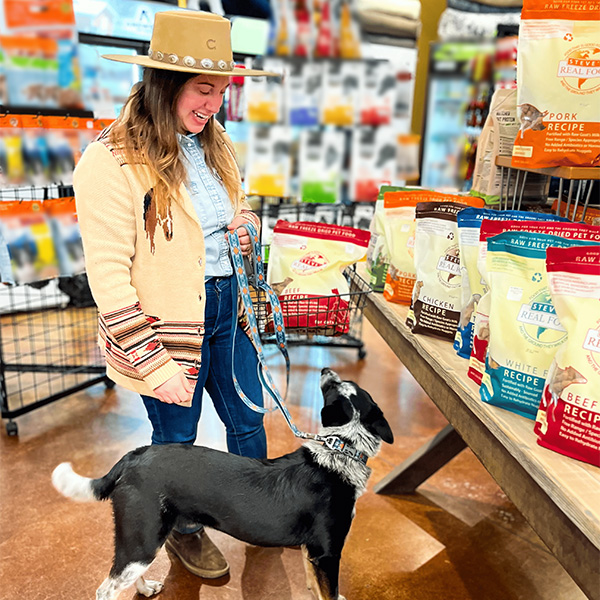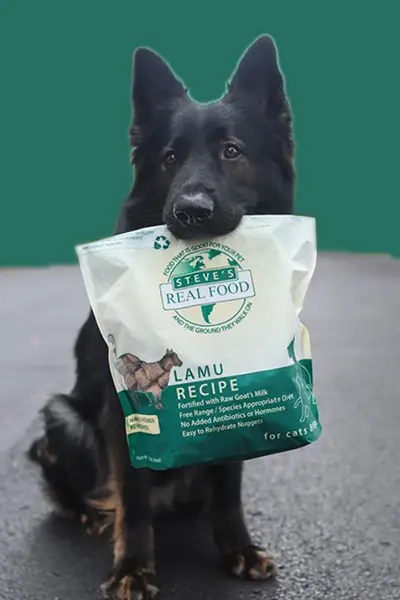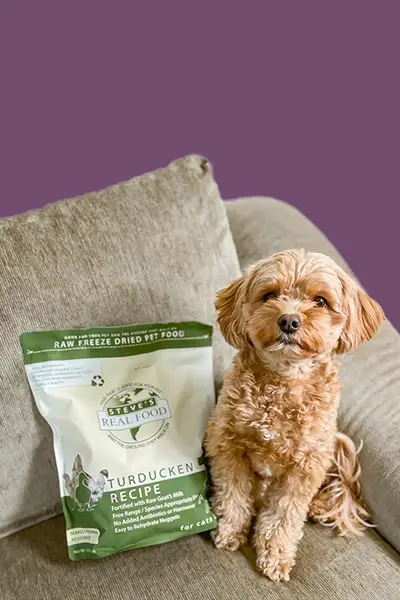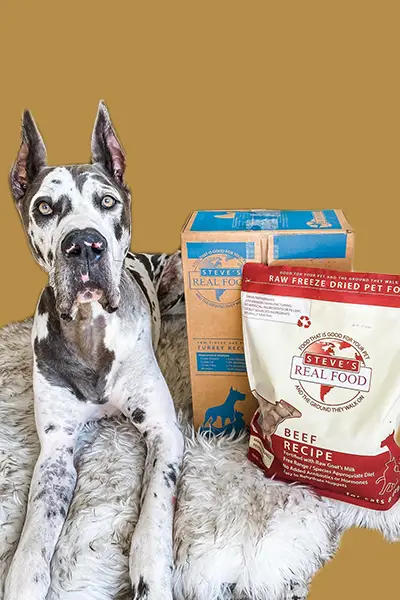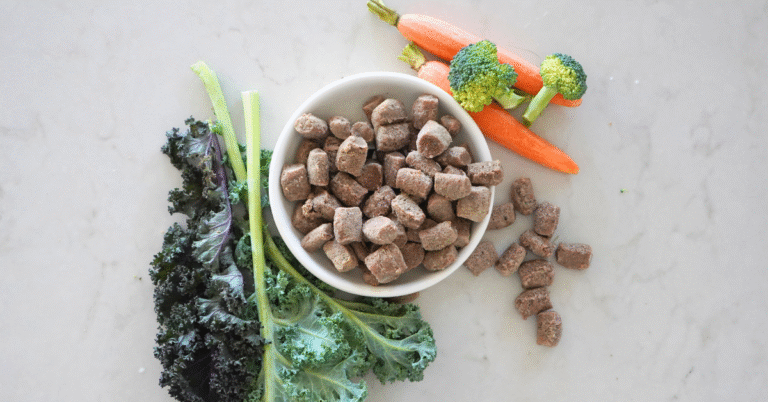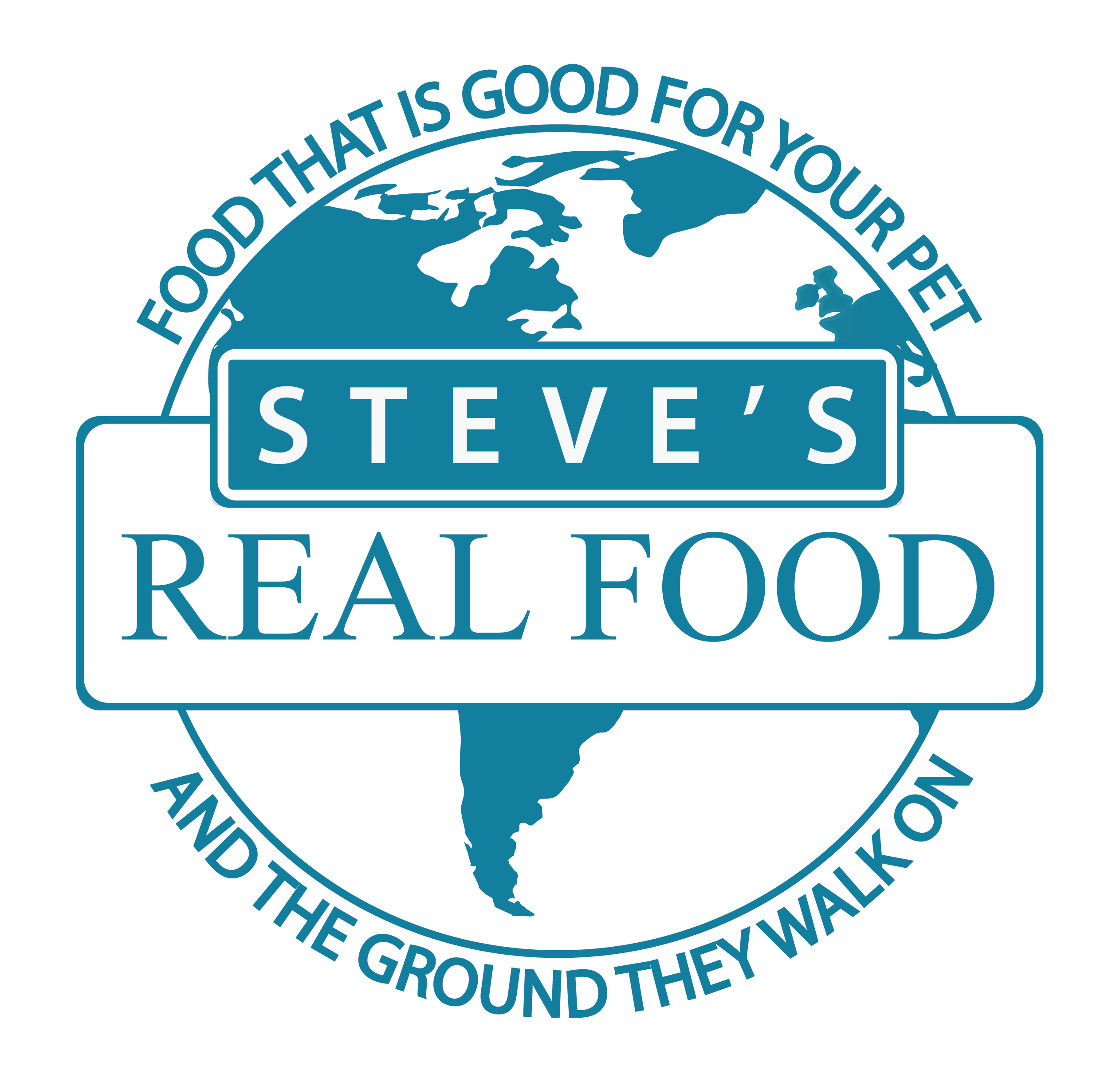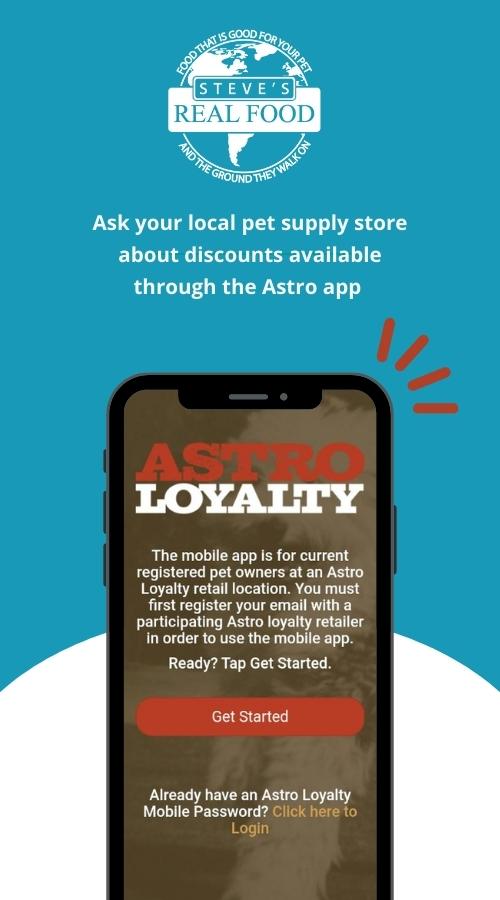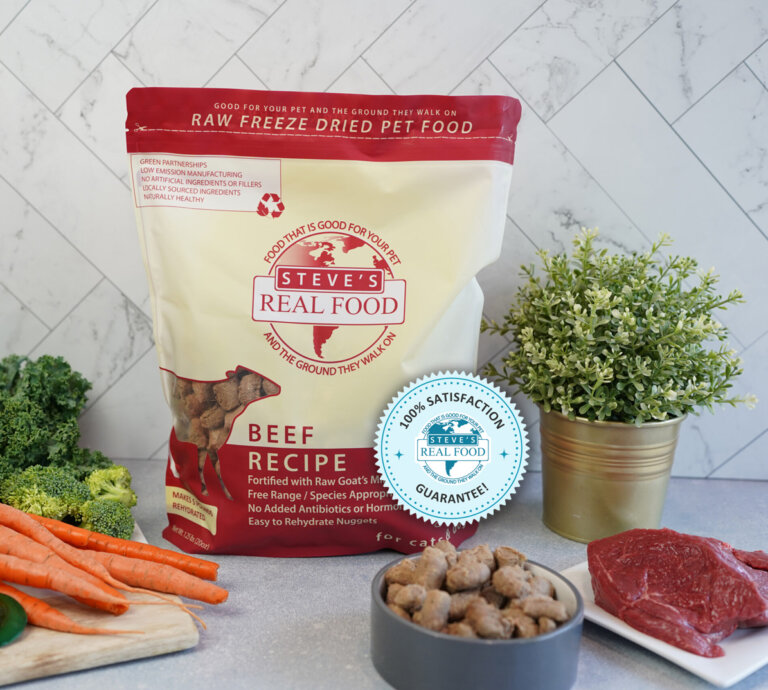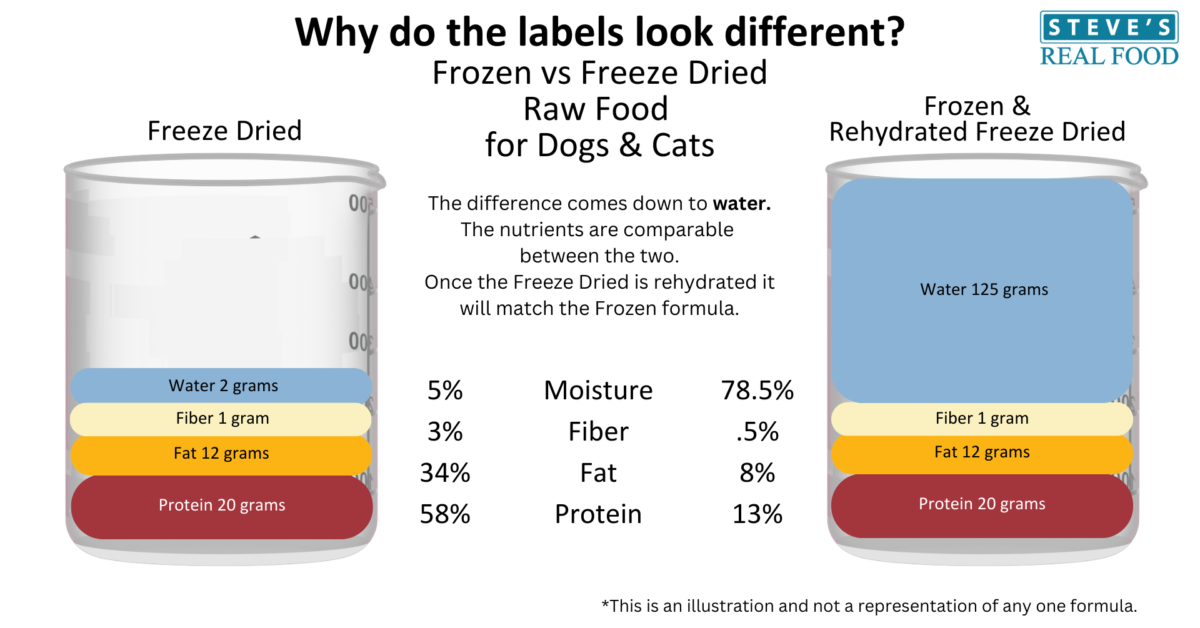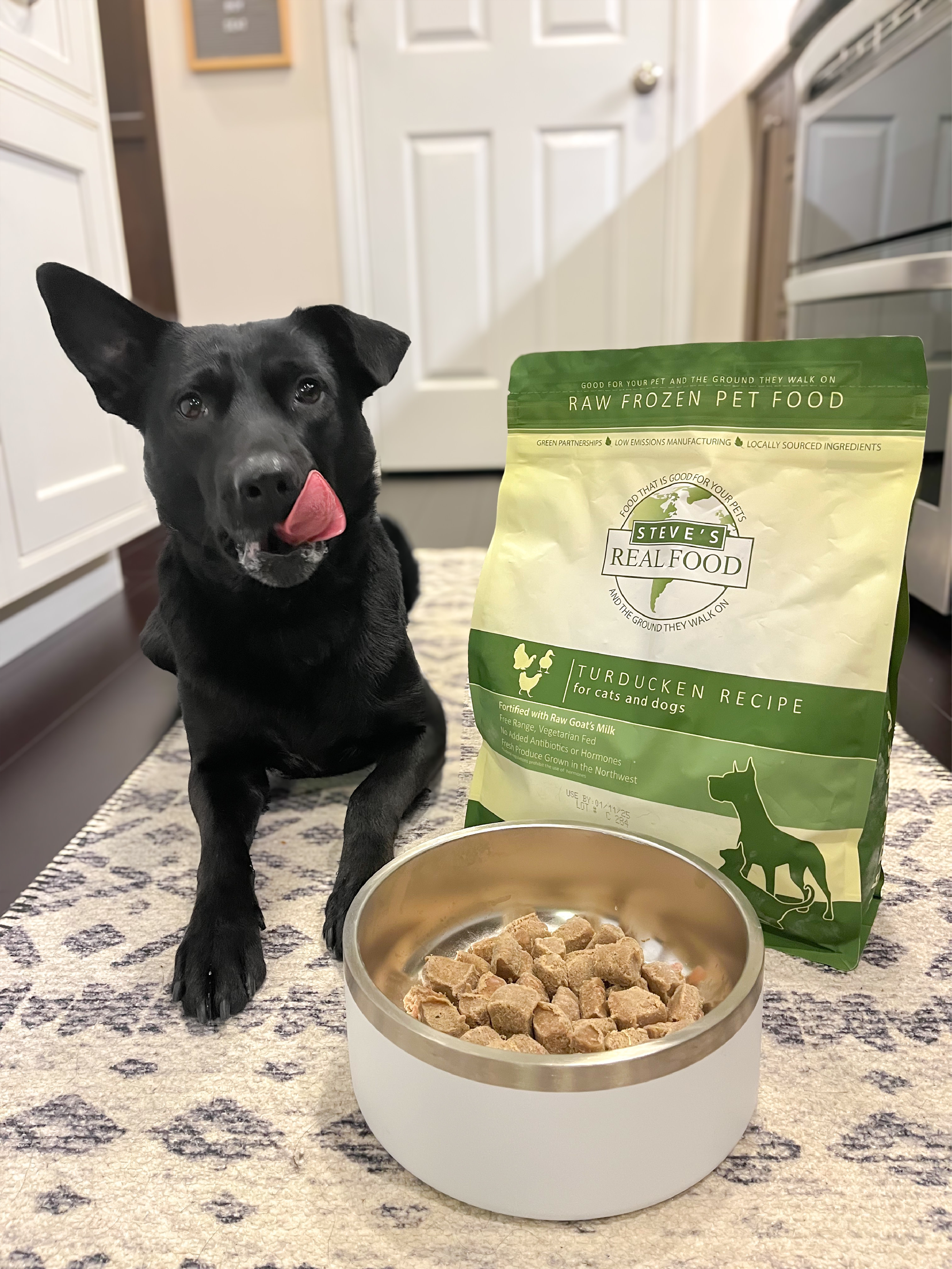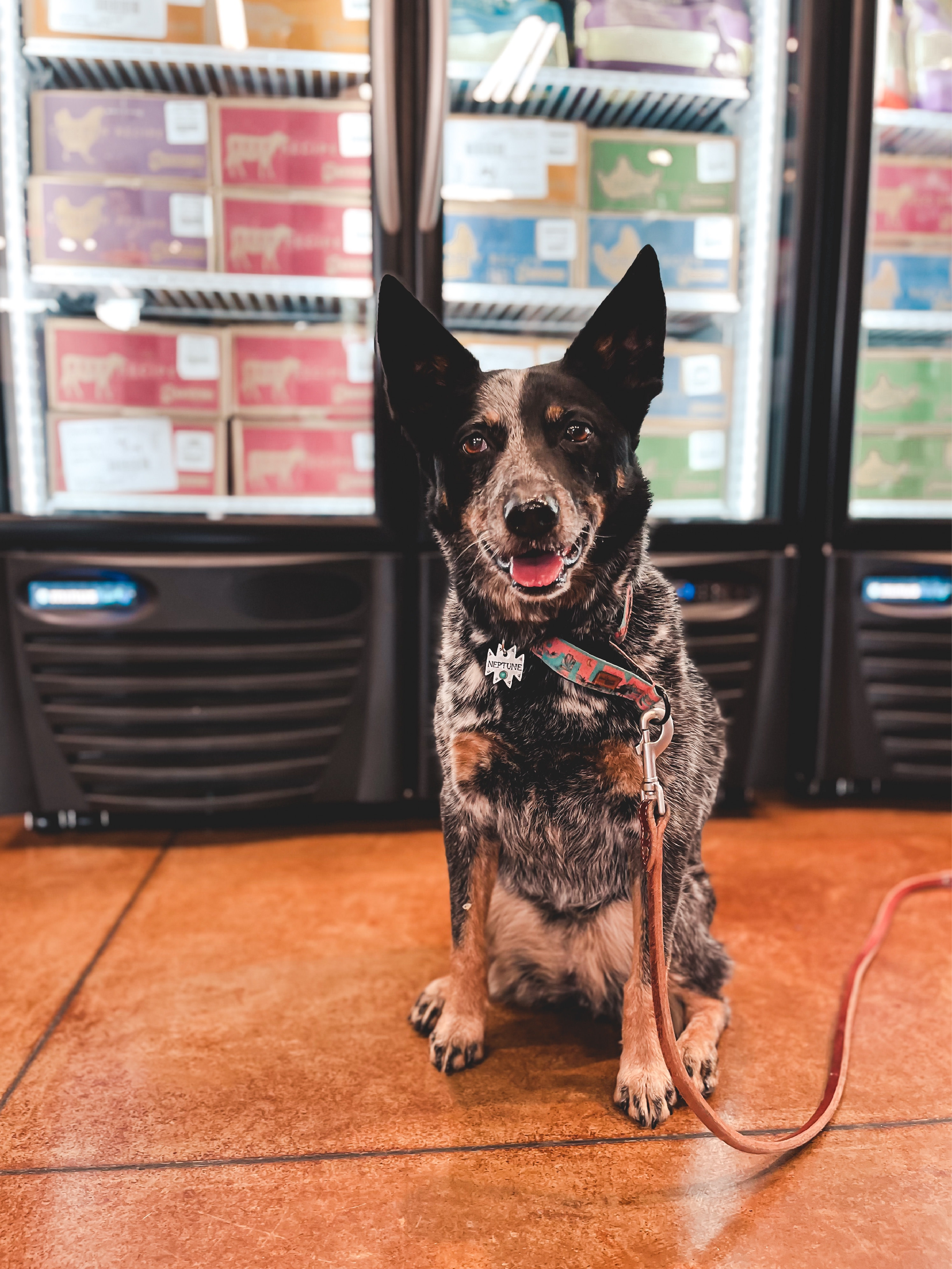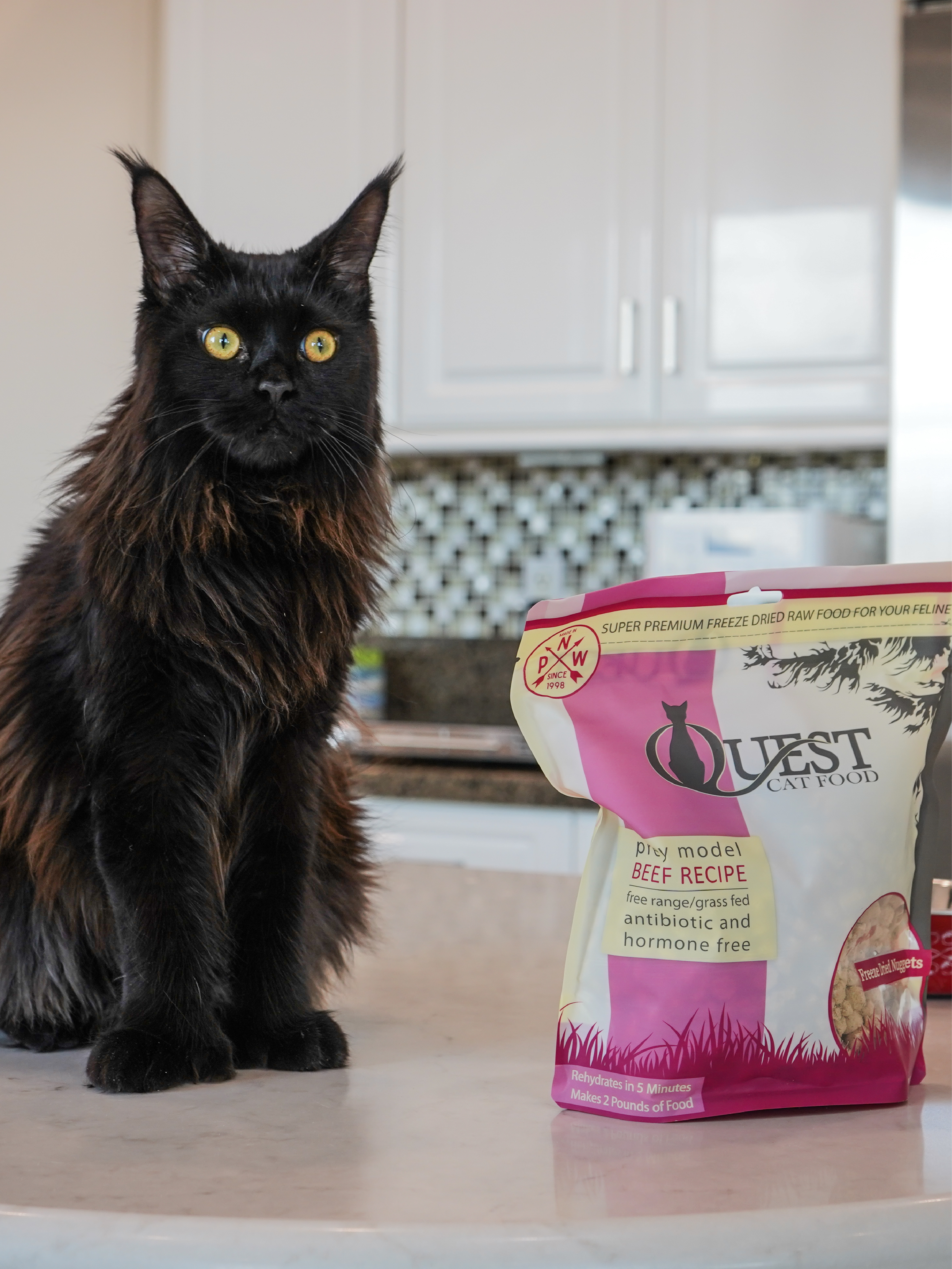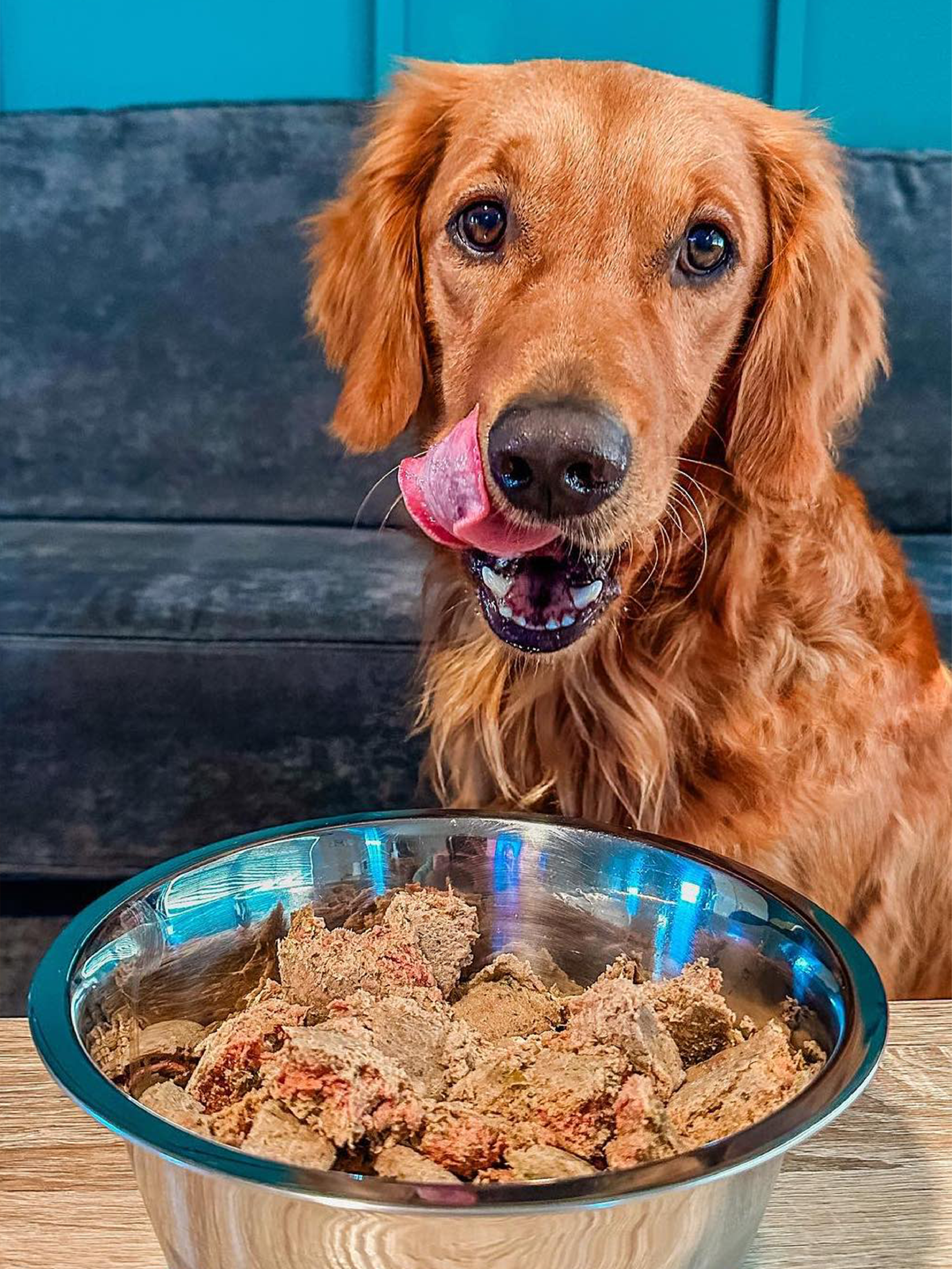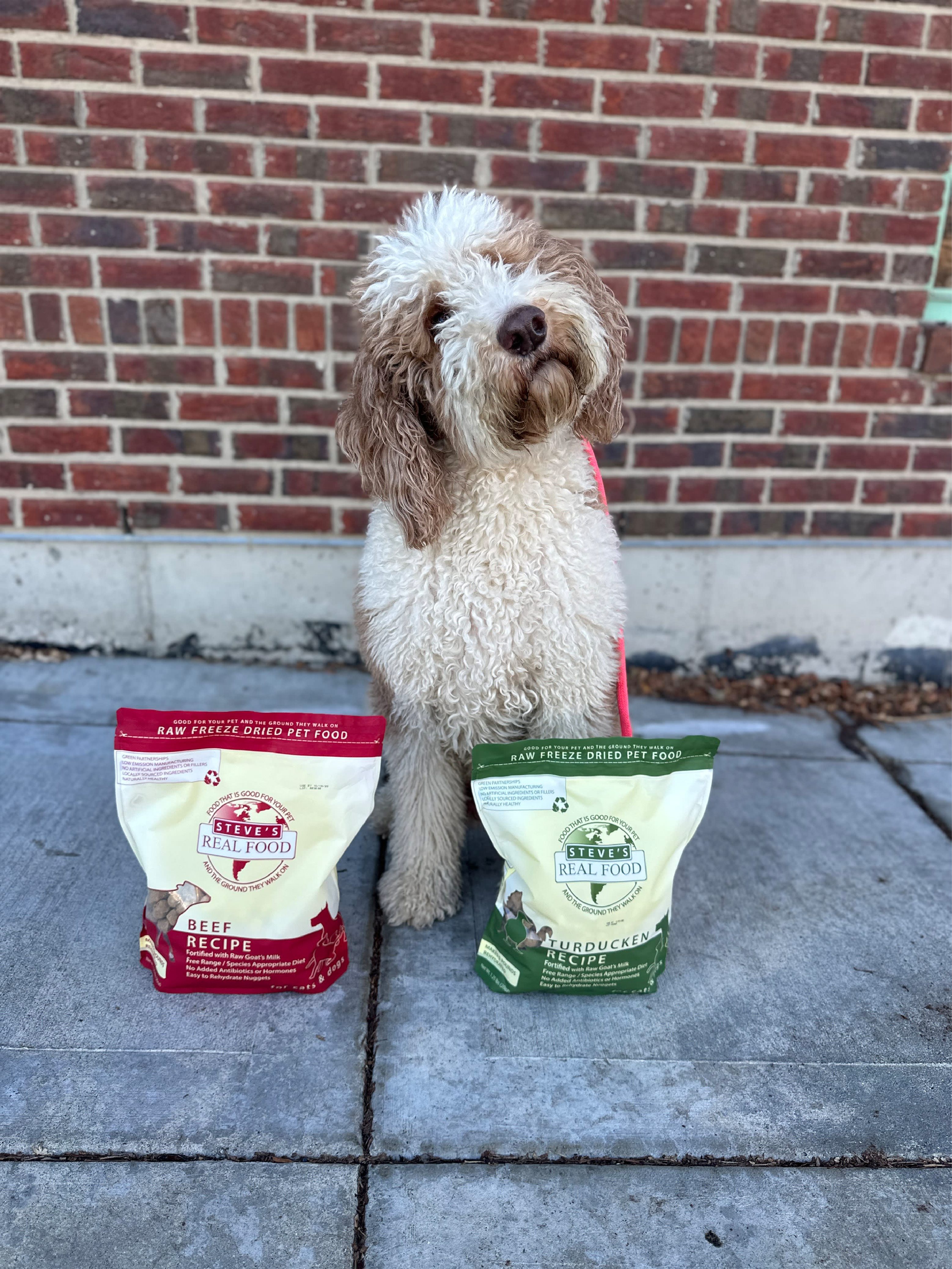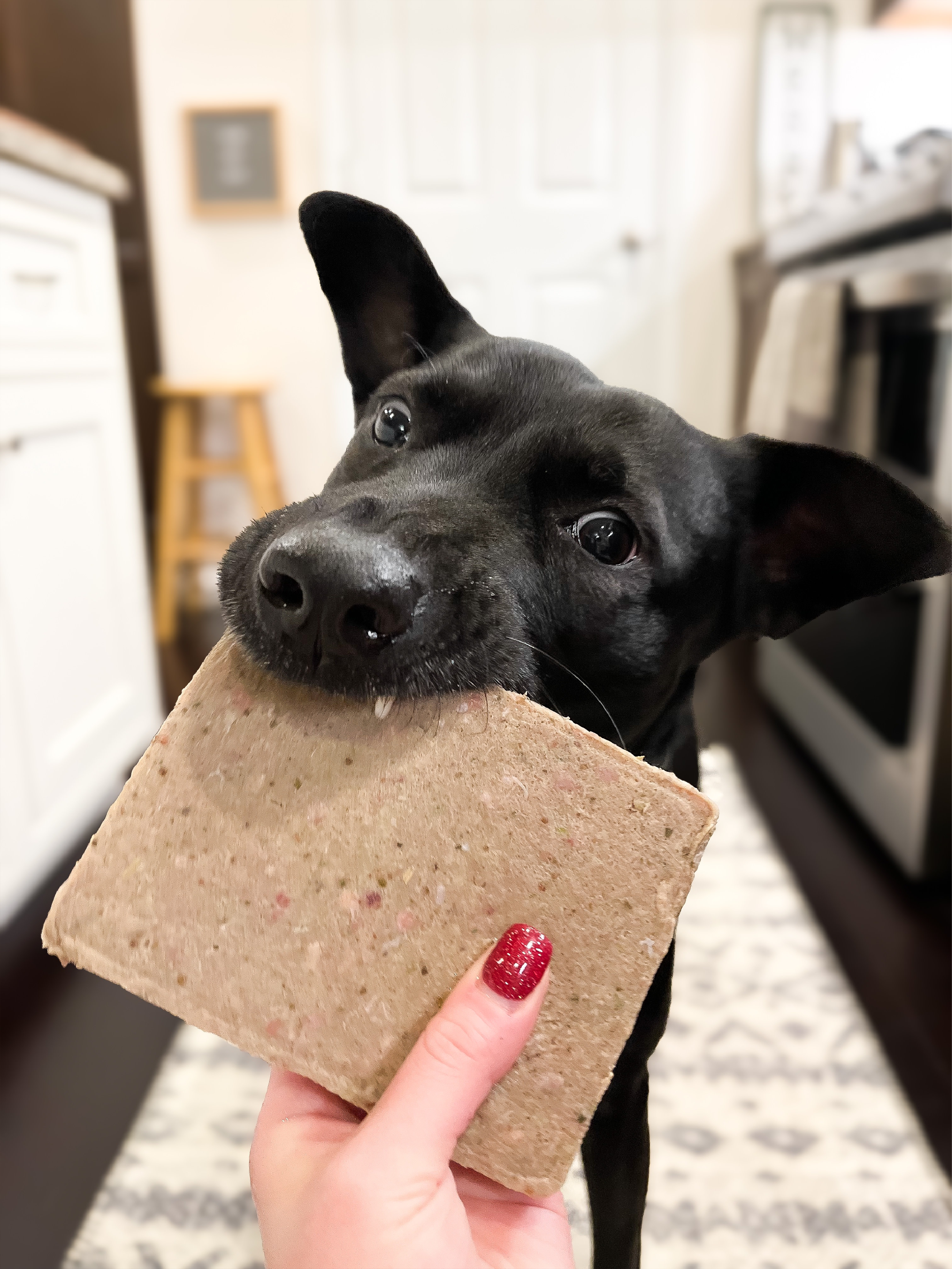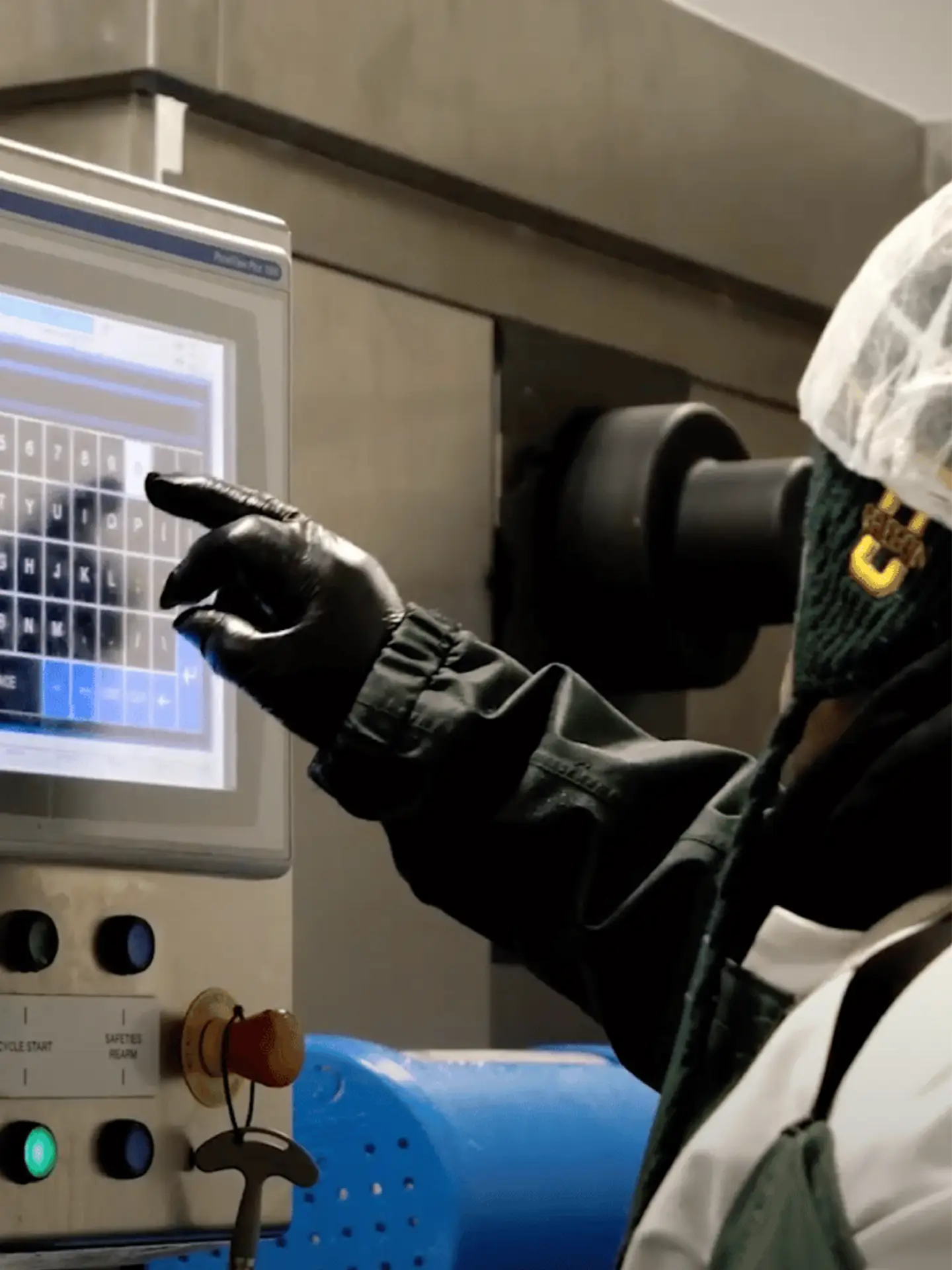Frequently Asked Questions
- Feeding
How do I start my pet on Steve’s Real Food?
Starting your pet on Steve’s Real Food is best achieved gradually over a couple of weeks. Begin by replacing a portion of your pet’s old food with the new food, and gradually adjust the ratio every few days—introducing a bit more new food while reducing the amount of the old. Most pets smoothly transition within about two weeks with no issues. Read more on transitioning here.
How many cups/patties are in a bag/box of Steve's Real Food?
There are 28 patties in a 14-pound box and 40 patties in a 20-pound box. Bags of nuggets are packaged by weight and not by number of cups, so cups of nuggets may vary slightly per bag. You get approximately:
- 16-18 cups from our 20 oz freeze-dried bags
- 20 cups from our frozen 5 lb bags of nuggets
- 40 cups from our frozen 9.75 lb box of nuggets
- 5-8 cups from our Quest cat food
How Do You Feed a Raw Diet?
Can I put freeze-dried raw in the fridge after it’s been rehydrated?
Can I feed Steve’s frozen? Can I warm it up?
Ideally, Steve’s Real Food should be fed thawed or slightly warm. It’s important not to cook the food as it harms or destroys valuable enzymes and nutrients. Ground bone is in every recipe, which should only be fed raw. For optimal serving, thaw the food in the fridge overnight and let it sit on the counter for up to an hour before serving. You can mix in hot water or bone broth for a warmer meal. Warming enhances aromas, making meals enticing for picky eaters and aiding digestion, which is especially beneficial for seniors, puppies, and dogs with digestive sensitivities. While some pets may do fine with cold meals, room temperature or warmer is advantageous for cats, smaller dogs, and those sensitive to colder temperatures. Our customer support can provide personalized guidance for specific concerns about serving temperatures.
How long does raw pet food stay good?
Our raw pet food is guaranteed to be fresh and nutritious through the date indicated on the package. In general, frozen diets maintain their quality for up to 18 months, while freeze-dried diets remain good for up to two years when stored properly. For optimal freshness, it’s crucial to adhere to storage guidelines. Keep frozen diets in the freezer until ready to use, and store freeze-dried diets in a cool, dry place. The food can be kept in the fridge for up to 3 days. Ensure the packaging is sealed properly to prevent any compromise to the food’s quality.
I am traveling with my pet, how do I keep feeding raw food?
Do I have to transition food between diets from the same company?
Can I mix Steve’s Real Food with other foods?
Can I Feed Steve’s Real Food Original Diets to Cats?
Yes, the original seven BARF diets are complete and balanced for both dogs and cats. Steve’s Real Food has developed a separate PREY model diet of frozen raw cat food and a freeze-dried raw cat food line to cater to our feline friends. Both options are complete and balanced for all stages of life.
Can Puppies and Kittens Eat Raw?
- Nutrition
What is the Normal pH of Steve’s Real Food, and is it Okay to Feed Pets with Kidney or Urinary Issues?
If you are concerned that your pet may have kidney or urinary issues, consult with your veterinarian. Veterinarians can provide tailored guidance on choosing an appropriate diet for your pet’s specific health condition.
What is the Calcium to Phosphorus Ratio?
The Calcium to Phosphorus Ratio may vary between 1:1 and 1.6:1, depending on the specific diet. This ratio is essential for pet nutrition, is crucial to bone health and overall well-being.
For precise information about a product’s Calcium to Phosphorus Ratio, reference our product pages. Each product page provides detailed nutritional information, allowing you to make informed decisions based on your pet’s needs.
Is the Food Okay to Feed Steve’s Raw Pet Food for Pets with Pancreatitis?
Raw food is often a healthy choice for pets with a history of pancreatitis, but it is essential to consult your veterinarian before introducing any new diet. Pancreatitis is a medical condition that requires careful dietary management, and individual pets may have different nutritional needs. Your veterinarian can evaluate your pet’s health condition, assess their dietary needs, and provide tailored recommendations for managing pancreatitis.
What is the difference between cooked food and raw?
What is the difference between the B.A.R.F. diet and Prey?
What is the caloric content of Steve’s Real Food and Quest Cat Food?
Is a commercially prepared raw diet better than a homemade one?
Do you have a diet to help my pet gain weight?
If your pet is underweight, try the following:
- Reference our feeding calculator and select “underweight” to see feeding recommendations tailored for weight gain
- Take note of your pet’s weight, and then feed that amount for two weeks
- After two weeks, check and note your pet’s weight
- If your pet is still underweight, increase the amount of food by 2%
- Feed the increased amount for two weeks
- Repeat steps 3 – 4 until the pet reaches the desired weight
Do you have a weight loss diet?
Can my diabetic pet eat your food?
It is crucial to consult with your veterinarian before changing your diabetic pet’s diet. Every pet is unique, and individual health conditions may require specific dietary considerations. Your veterinarian can provide personalized advice based on your pet’s health status, weight, and other relevant factors. We recommend reviewing the detailed information on our product pages to facilitate the discussion with your vet. These pages contain valuable information about our diets’ vitamins, minerals, and other nutrients. Bringing this information to your vet appointment can assist in determining the appropriateness of our products for your diabetic pet.
Why is there a difference in protein percentage between frozen and freeze-dried raw pet food labels, even though they have the same ingredients?
The difference in protein percentage comes from the way nutrition is calculated on an as-fed basis. Frozen and freeze-dried raw pet foods have different moisture contents, which affects the percentage of nutrients, including protein, listed on the label.
- Frozen raw pet food typically contains a high moisture content (about 60-70%). When the moisture is factored in, the protein percentage appears lower, around 12% on the label.
- Freeze-dried raw pet food, on the other hand, has most of its moisture removed during the freeze-drying process, leaving concentrated nutrients. This can result in a higher percentage of protein listed on the label, often around 40%.
Even though the ingredients are the same, the difference in water content changes the percentage of nutrients per weight. The actual amount of protein your pet gets from either form is nearly the same when you account for the moisture differences.
- Safety
Why has the color of the food changed since the last bag I got?
The variation in color you may notice in our raw pet food is completely normal and is a result of using natural, real food ingredients. Because we prioritize using unprocessed, whole foods, differences in color, odor, and texture can naturally occur. The color of produce, for instance, can vary based on when it’s harvested.
Additionally, animals harvested at different ages, during various seasons, and while consuming different diets can influence the color of recipes such as pork, beef, and chicken. They can range from a light tan or grey to a darker red, reflecting the natural diversity in the ingredients we source.
It’s important to understand that these variations are not a cause for concern; rather, they signify that we are using all-natural ingredients and keeping our processing to a minimum. There is no uniformity in nature, embracing these natural differences is integral to our commitment to providing wholesome, unadulterated nutrition for your pets. If you have any specific questions or concerns, send a picture of the food to our customer support team at [email protected].
What is AAFCO?
AAFCO is short for the American Association of Feed Control Officials. The regulatory organization advises each state on regulating pet food entering their state. They also have determined the levels of vitamins and minerals a food must have to be classified as Complete and Balanced for All Life Stages. This designation means that diets have been formulated to ensure they have the nutrients necessary for good health over the lifetime of your pet. However, AAFCO standards are easy targets and can be achieved using low-grade ingredients. Many commercial dry pet food companies have spent hundreds of thousands of dollars to figure out the cheapest ingredients available that will yield the test result necessary to pass. Raw food, on the other hand, naturally exceeds the AAFCO requirements.
What is the shelf life of both frozen and freeze-dried products?
For optimal freshness, it’s crucial to adhere to storage guidelines. Keep frozen diets in the freezer until ready to use, and store freeze-dried diets in a cool, dry place. Ensure the packaging is sealed properly to prevent any compromise to the food’s quality.
How is your food rated for all life stages?
Our pet food is formulated to meet the dietary requirements set by the Association of American Feed Control Officials (AAFCO) for all life stages. AAFCO establishes comprehensive nutritional standards to ensure that pet food provides the essential nutrients needed for pets at every stage of life, from puppies and kittens to adults and seniors.
By adhering to AAFCO guidelines, our food is designed to offer a balanced and complete diet that supports growth, development, and maintenance throughout your pet’s life. Whether you have a playful puppy or a mature cat, you can trust that our pet food is crafted to provide the necessary nutrients for optimal health at every life stage.
How is your food rated for both dogs and cats when they have different nutritional requirements?
Are raw meat-based diets safe?
A crucial step in our manufacturing process is the implementation of high-pressure processing (HPP), a cold-water pressure method that effectively eliminates harmful bacteria from the food. Furthermore, every batch undergoes thorough testing for pathogenic bacteria, and nothing leaves our facility without obtaining negative test results.
At home, treating your pet’s food with the same care as you would raw meat for your family is important. Keep the food at a safe temperature and practice good hygiene by washing hands and surfaces that come in contact with the food. Following these safe handling practices significantly minimizes the risk associated with feeding raw foods,ensuring the well being of your pets.
Why can dogs and cats eat raw meat, but humans cannot?
digestive systems and evolutionary adaptations. Here are the key reasons:
- Digestive System Variation:
-
-
- Stomach Acidity: Dogs and cats have highly acidic stomachs, which help break down and kill harmful bacteria in raw meat.
- Shorter Digestive Tract: Their digestive systems are shorter, reducing the time for potentially harmful bacteria to cause issues.
-
- Evolutionary Adaptations:
-
-
- Carnivorous Nature: Dogs and cats are carnivores, and their digestive systems have evolved to handle raw meat efficiently.
- Natural Resistance: Over time, these animals have developed a level of resistance to certain bacteria commonly found in raw meat.
-
- Enzymatic Differences:
-
-
- Digestive Enzymes: Dogs and cats produce more digestive enzymes, particularly in their saliva, that help break down raw meat efficiently.
-
- Historical Diet:
-
-
- Wild Ancestry: In the wild, dogs and cats consume raw meat as part of their natural diet. Domestication has not significantly altered their ability to handle raw foods.
-
For humans, consuming raw meat poses a higher risk of bacterial contamination and foodborne illnesses due to differences in our digestive physiology. Humans have a longer digestive tract and less acidic stomachs than carnivorous animals, making us more susceptible to bacterial infections from raw meat.
It’s important to note that while dogs and cats can handle raw diets, proper hygiene and food safety practices are crucial to minimize the risk of bacterial contamination for both pets and humans.
How do you prevent E.coli, Salmonella, and other microbes from contaminating the raw pet food?
Is Raw Pet Food Made with Pork Safe? What about Parasites in Pork?
The parasite that causes the most concern in pork is a roundworm called Trichinella spiralis. It can cause the disease trichinosis. It used to be common in the United States, but that was long ago.
Even though the risk is already very low, we take several steps to ensure our pork diets are clean and safe, starting with sourcing from high-quality family farms that raise free-range pigs fed a species-appropriate diet. Our manufacturing process includes high-pressure processing. This cold-water pressure method effectively eliminates pathogens such as harmful bacteria and parasites. Finally, we freeze the pork to temperatures well below what the CDC recommends for killing trichinella and other parasites.
Is it ok to let a dog lick my face after eating raw food?
Ultimately, deciding to let your dog lick your face is a personal preference. A clean raw food like Steve’s, which has all of the safety steps in place, won’t increase or decrease any risk of sharing germs, but it can help reduce tartar build up, which is a breeding ground for bacteria.
What if I see a lot of freezer burn?
- Frost: Forms when food is frozen, and the moisture creates ice crystals, which can evaporate and condense on the surface. It will resemble “snow” in the bag. These crystals can increase during small temperature fluctuations (even opening a freezer door for a few minutes). The presence of frost does not indicate that the food has thawed and refrozen. It will not affect the nutritional quality, nor should it compromise taste or texture.
- Freezer Burn: This generally occurs when the food is exposed to air in the freezer, leading to the dehydration of the outer layer of the food, which usually takes months and months. Freezer burn manifests as discolored, dried-out patches on the surface of the food. Freezer burn can affect the food’s taste and texture, making it dry and less flavorful. While it doesn’t pose a health risk, it can lead to a decline in the overall quality of the frozen item.
To avoid freezer burn at home, don’t buy more food than you can use in a couple of months, rotate your stock, prevent long-term exposure to air, and keep your freezer running at its best. Routine defrosting and cleaning of the coils is recommended.
Why are there chunks of bone in the food?
- Ingredients
Do you use synthetic vitamins or minerals?
Where do you source your ingredients from?
We take great care in sourcing our ingredients to ensure the highest quality and ethical standards. Our meat comes from human-grade, USDA-inspected facilities that prioritize sustainable farming practices and humane treatment of animals. Exceptions include the lamb, which we get from New Zealand.
Our commitment to transparency means no fillers, preservatives, or unwanted additives are in our food. For complete confidence, a comprehensive list of our food sourcing is available on our ingredients page.
Are your ingredients organic?
Are your ingredients GMO-Free?
Yes, we solely use GMO-free ingredients.
Does any of your meat contain thyroid?
No, all our meat and poultry are processed in the same USDA-inspected plants that human food is made in, which means the thyroid is not allowed in the product.
Why use fruits and vegetables in your pet food?
Why are raw pet foods healthier?
Does your food use any preservatives?
In the case of our shelf-stable diets, we employ freeze-drying as a preservation method. This process removes moisture from the food, preventing the growth of bacteria and mold without the necessity for artificial preservatives. The result is a shelf-stable product that maintains its nutritional integrity while avoiding the use of chemical preservatives.
- Manufacturing
Is your packaging BPA-free?
What tests do you do on the food?
We prioritize the safety and quality of our raw pet food through the following comprehensive testing procedures:
- Microbial Testing: Regular testing for Salmonella, E. coli 0157-H7, and Campylobacter is conducted to ensure the absence of harmful bacteria.
- Pathogen Testing for Meats and Goat Milk: Some meats and goat milk undergo pathogen testing before entering the pet food manufacturing process, adding an extra layer of scrutiny.
- Batch Testing: Every batch of pet food undergoes thorough testing for pathogens to guarantee safety.
- Environmental Contaminant Testing: Our foods are tested for pesticides, heavy metals, and other environmental contaminants to meet stringent safety standards.
- Quarterly Nutrient Testing: Pet foods are tested quarterly for guaranteed analysis, including calcium, phosphorus, zinc, copper, and other essential minerals.
- Bi-annual Nutritional Analysis: A complete vitamin analysis and full nutritional profiles of pet foods are performed every six months.
- Transparency: Thorough nutrition information for each product is shared on the website.
Where is Your Manufacturing Plant, and Do You Own It?
The plant is located in Oregon. We do not own this facility, but we work extremely closely with our co-packer, who grew up working in a raw pet food plant, his family business. He left the family business to go in his own direction and manufacture Steve’s Real Food.
Do you use HPP?
We use HPP for all our formulas. After two years of rigorous research, it has proven to be the best solution to manage the microbial environment without synthetic preservatives. We conducted testing of 95 nutrients and saw no significant change in nutrient value. HPP inactivates food-borne pathogens such as Salmonella, E. coli, STEC- E.coli, and Listeria without changing the nutritional value of the food. It offers a safer option for consumers who are worried about food safety, have small children, are immune-compromised, or have a pet who is immune-compromised. Please read this bog about our decision and to view the results of our extensive testing.
How do you make the food?
Our food is manufactured under USDA and HACCP guidelines and stored below freezing. We make our formulas with sterilized processing equipment to prevent any possibility of contamination, and our machines undergo rigorous cleaning after every round of production. When you enter the facility, you must wash your hands and dip your footwear in a chlorine bath. Smocks, hair/beard nets, and gloves must be worn to protect the product from contamination.
Is your facility inspected?
We keep our food clean by using high-quality ingredients and following strict manufacturing processes. The FDA and the Oregon Department of Agriculture regularly inspect our factory, and both have shown approval for the high standards of cleanliness and quality they found there, remarking that our facilities go beyond their expectations.
 Beef
Beef Chicken
Chicken Whitefish
Whitefish Pork
Pork Lamb
Lamb Turkey
Turkey Turducken
Turducken All Protein
All Protein Beef
Beef Chicken
Chicken White Fish
White Fish Pork
Pork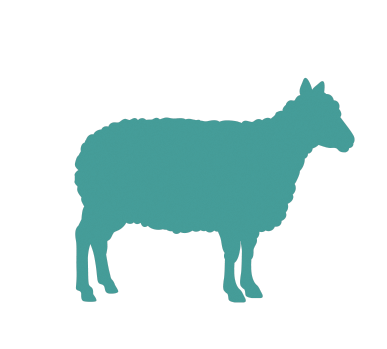 Lamb
Lamb Turkey
Turkey Duck
Duck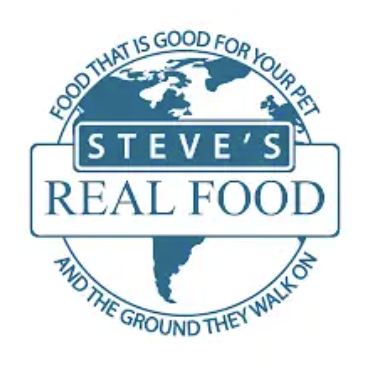 All Products
All Products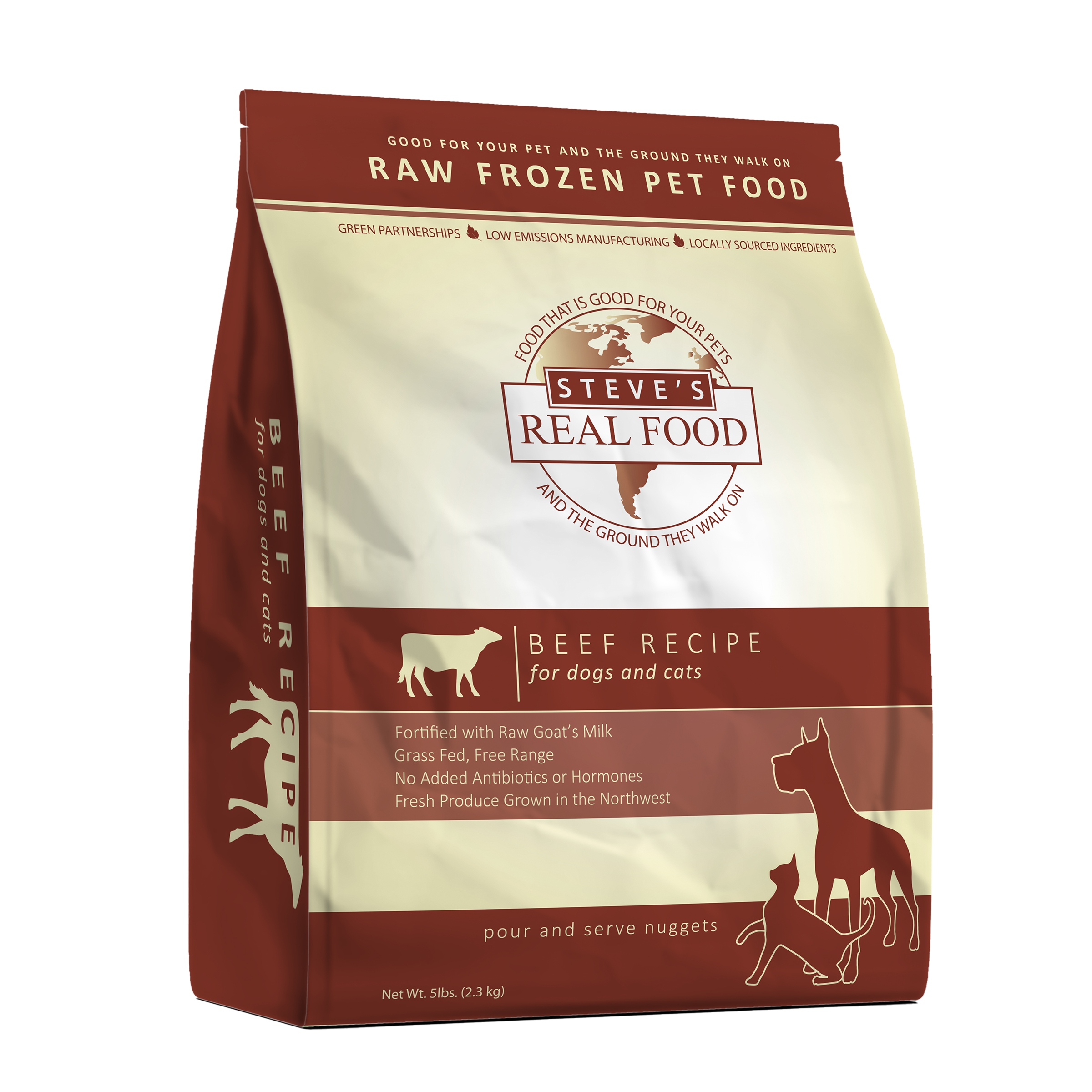 Frozen Raw Pet Food
Frozen Raw Pet Food
 Freeze Dried Raw Pet Food
Freeze Dried Raw Pet Food
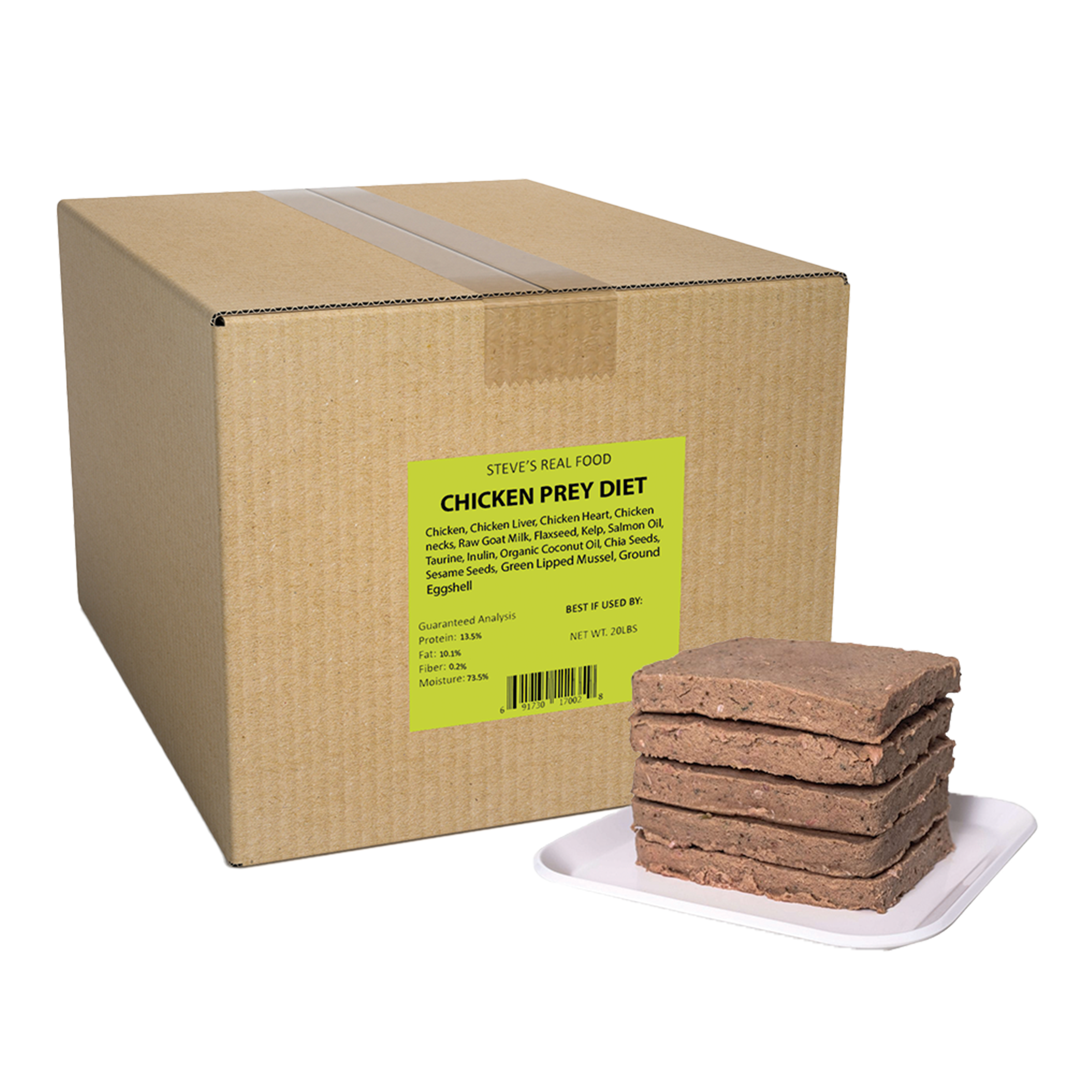 Frozen Prey Diet
Frozen Prey Diet
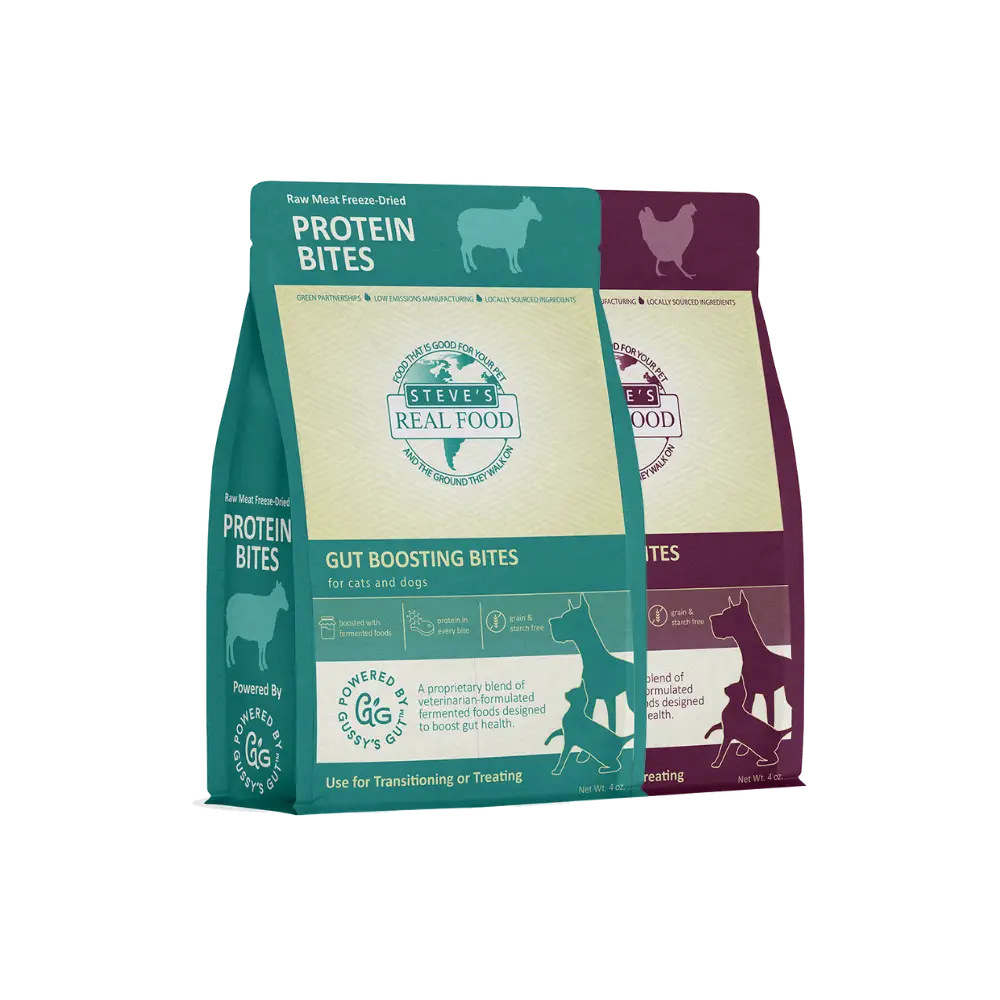 Freeze Dried Protein Bites
Freeze Dried Protein Bites
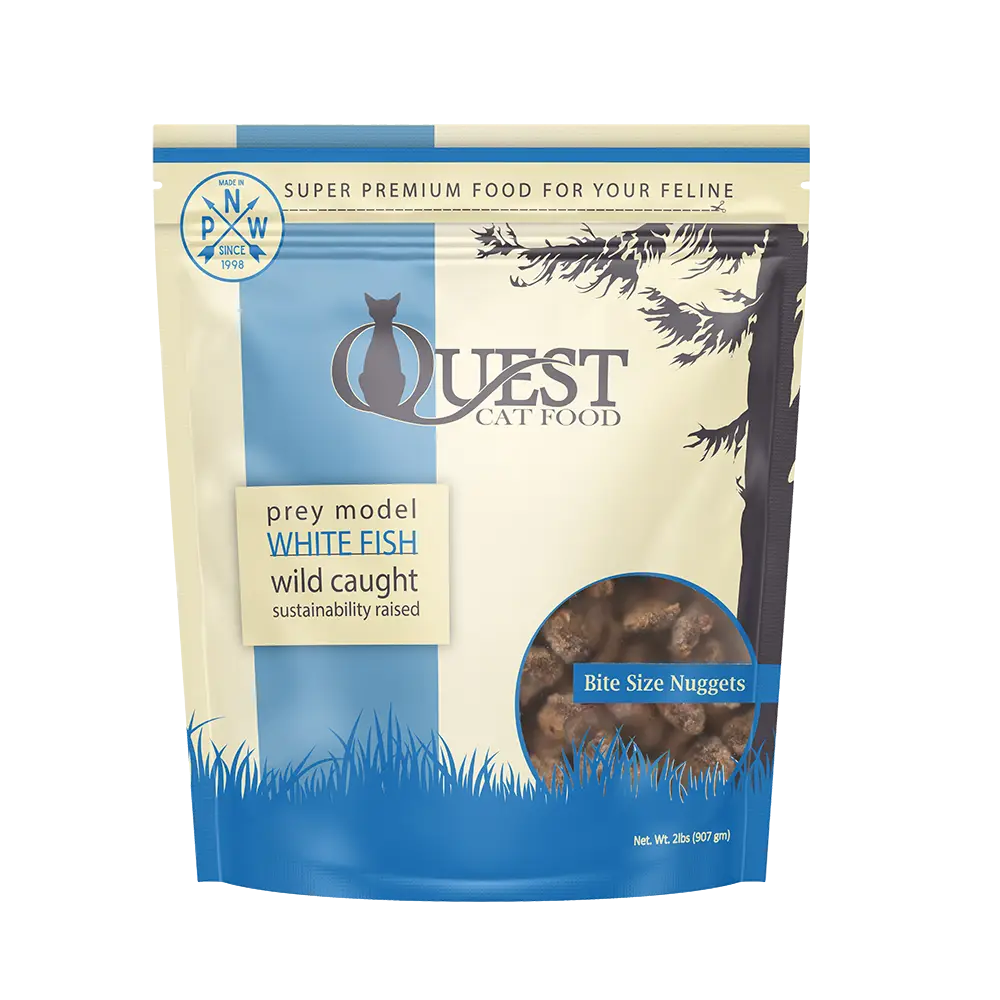 Frozen Quest
Frozen Quest
 Freeze Dried Quest
Freeze Dried Quest
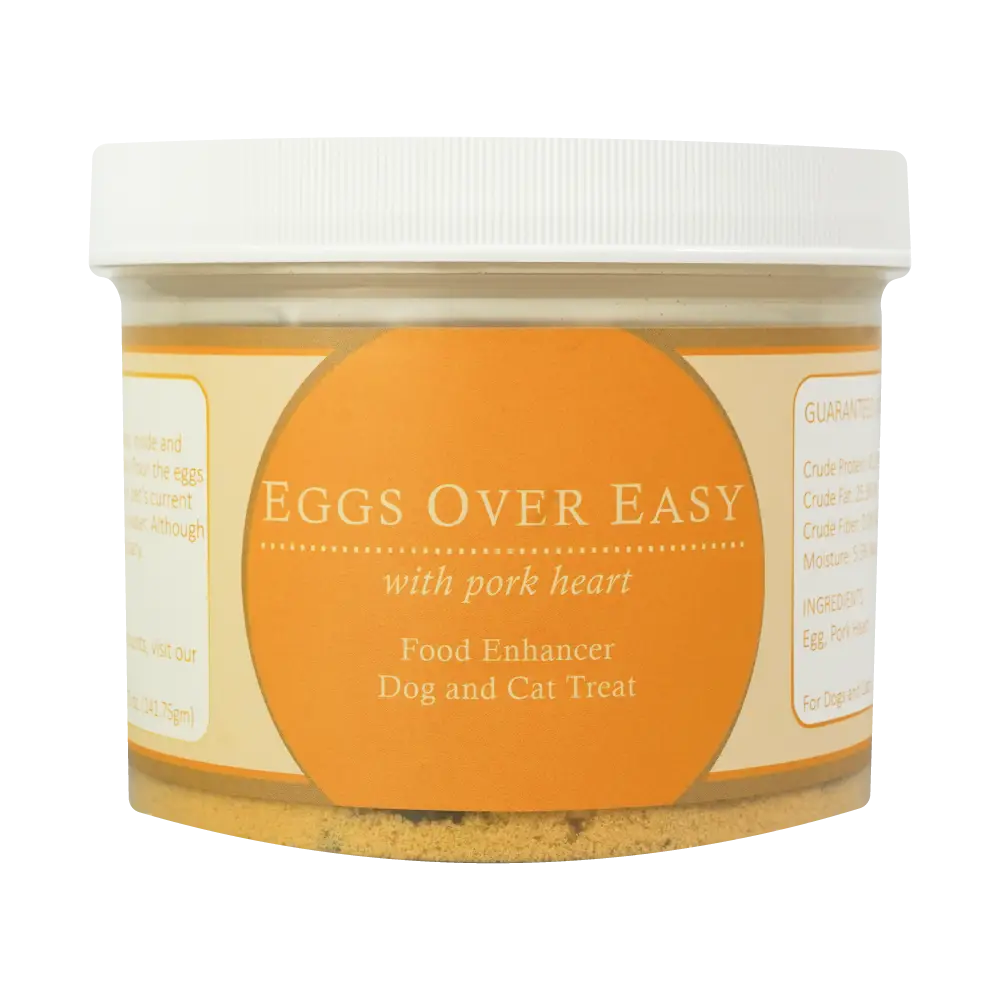 Eggs over Easy
Eggs over Easy
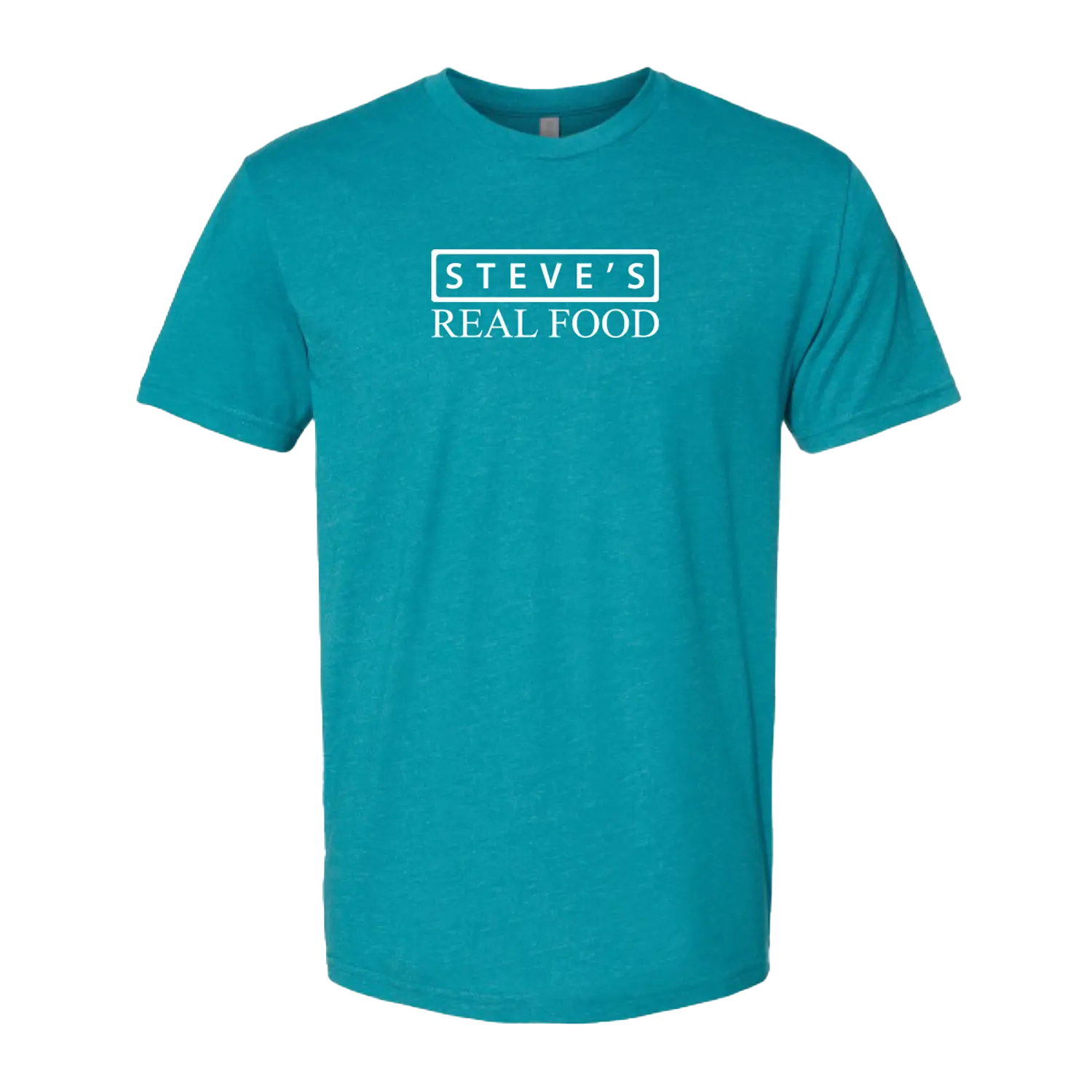 Steve's Merch
Steve's Merch 